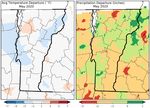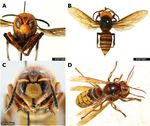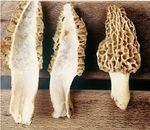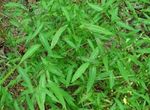Vermont Forest Health - Insect and Disease Observations - May 2020 - Department of Forests, Parks and ...
←
→
Page content transcription
If your browser does not render page correctly, please read the page content below
Vermont Forest Health
Insect and Disease
Observations — May 2020
Department of Forests, Parks & Recreation
May 2020 vtforest.com
Weather Recap
This month’s weather started off cold and
wet, with snowfall occurring in most parts
of the state through mid-May. Compared
to last year, this month was warmer and
dryer than May of 2019. Statewide tem-
peratures averaged 52.9°F, which was 2
degrees warmer than May of last year.
Statewide, precipitation averaged 2.93
inches, which is 2.73 inches less than May
of last year. Minimum relative humidity
(RH) values for the Northeast Kingdom
were below normal. On May 23rd and
24th, the low RH at the Nulhegan remote
automatic weather station was 12%, and Temperature and precipitation departure from
the low RH in Montgomery and Walden normal. Maps and data: Northeast Regional Cli-
was 8%. This, combined with no precipi- mate Center.
tation since May 16th, caused extremely
dry fuel conditions and resulted in several fires. Soil moisture drought indices are approach-
ing mid-summer values and large dead fuels are at the seasonal minimum.
This spring has delayed green-
up in most parts of the state,
with many species breaking
buds later in the month. Photo
credit: FPR Staff.
Sugar maple phenology at our long-term monitoring site in Underhill had observed bud break
on May 11th, with full leaf-out following two weeks later on May 26th. Each date is 8 days
later than the long-term average. Some parts of the state experienced frost on May 11th and
12th, which damaged understory sugar maple. No impacts on upper canopy foliage were re-
ported.Insects in the News: Asian Giant Hornets
Asian giant hornet (Vespa mandarinia), also
known as the murder hornet, is the world’s
largest hornet and is native to Asia and Russia.
Although they can be dangerous to people, this
insect gets its common name by killing honey-
bees and feeding the corpses to their young. In
its native range, honeybees protect their nest
by working together to swarm these large in-
vaders. Collectively, honeybees can surround
the hornet and kill it by raising its internal tem-
perature. See this teamwork in action in this
video. This hornet was recently detected in
Washington state and has not yet been detect-
ed in the eastern U.S. This is a species of con-
cern to native U.S. honeybees because they
have not adapted a defense mechanism, mean-
ing that hives can be destroyed in a quick time A-B) Asian giant hornet. Photo credit:
period. Despite the media attention this insect Washington State Department of Agricul-
has attracted, this is not a species of con- ture. C-D) European hornet. Photo credit:
cern for human health or safety in Ver- (C) Buck et al. 2008 University of Guelph,
mont. These hornets are 3.5-5cm in length Ontario, Canada (D) Sven Teschke.
and can have a wingspan up to 4-7cm. The
most distinct characteristic is their large orange head and black eyes. For more information
check out USDA National Invasive Species Information Center and Washington State Depart-
ment of Agriculture websites.
In Vermont, you may see an invasive look-a-like known as the European hornet, Vespa
crabro. This hornet is also large, measuring 1.8-2.4 cm in length and can have a wingspan up
to 2.5-3.5 cm. This is distinguished from the Asian giant hornet by its smaller size and colora-
tion. For more information or to report a sighting, visit vtinvasives.org.
Funky Fungi
Cryptococcus macerans was observed covering the surface of
hardwood trees in Hubbardton, VT. This bright orange fungus is
not harmful to the tree and only feeds on the extruded sap
from preexisting damages. This fungus is commonly observed
in Spring due to the rich sap flow and is often associated with
wounding from yellow-bellied sapsuckers and tap holes. This
fungus gets its bright orange color form the pigment carotene,
the same pigment found in carrots. Although its color and ir-
regular shape make it look out of this world, this is a cosmopol-
itan fungus, meaning it can be found across the globe.
Cryptococcus macerans. Photo credit: Irene Garvey.The “More”l You Know
May starts the beginning of morel (Morchella escu-
lenta) season in Vermont. This highly sought-after
edible is a fungus native to the eastern United
States. Although they can be hard to find, your
chances can increase by foraging in mixed hardwood
stands that include apple, ash, aspen, elm, and oak.
In the early spring, these mushrooms are commonly
found on south-facing slopes in open-grown areas
and are found deeper in the woods on north-facing
slopes as the season progresses.
True morels can be identified by a more uniformly
shaped cap that is covered in pits and ridges. This
cap is attached directly to the stalk of the mush-
room, and when sliced in half, this mushroom is
completely hollow. This mushroom has many look- True morels. Photo credit: Gary
alikes, including (but not limited to) the false mo- Lincoff, the Complete Mushroom
rels, Gyromitra esculenta and Verpa bohemica. Nei- Hunter.
ther of these false morels are completely hollow,
and they are typically less uniformly shaped. G. esculenta is solid, and a cross-section would
reveal a cauliflower–like internal structure. The cap of this mushroom is brain shaped, and is
often described as squished. This species, although consumed in some cultures, can be fatal
if eaten raw or uncooked, due to the carcinogenic mycotoxin, gyromitrin. Mycotoxins are sec-
ondary metabolites produced by fungi that are not directly involved with normal growth and
reproduction. These metabolites may indirectly aid in growth and competition, however their
true purpose is still being researched. Levels of these toxins can vary between and within
species, and unless laboratory work is conducted, actual levels cannot be assessed. V. bo-
hemica has a cap that hangs freely from the stem, only connected at the top of the stalk. Alt-
hough the cap is hollow, the stem is not. This species of mushroom is reported as suspect
and toxic, and is not recommended for consumption. As with all wild mushrooms, there are
risks to eating and mis-identifying them which can be both dangerous and fatal. Always en-
sure you have the correct identification before consuming any wild edible. The State of Ver-
mont accepts no liability
or responsibility for the
consumption and/or misi-
dentification of these
mushrooms.
A: True morel, M. esculen-
ta, B: False morel, G. es-
culenta. Photo credit: Da-
vide Cassi, University of
Parma, Italy. C: False mo-
rel, V. bohemica. Photo
credit: Jason Hollinger.Hemlock Woolly Adelgid Update
Hemlock trees in Townshend, VT experienced a heavy hemlock
woolly adelgid (HWA) infestation during 2012- 2014. 2020 HWA
density assessments in this area indicate that populations are
greater than previous years, and trees are again experiencing high
infestations. These insects cause yellow needles, needle fallout,
branch dieback, crown thinning, and can lead to mortality of in-
fested trees. For more information on HWA, please see our guide
for landowner response to the insect.
HWA infested trees in Townshend, VT. Photo credit: FPR Staff.
May Invasive Plant Phenology
Volunteers are keeping track of invasive plant phenology in order to time management treat-
ments most effectively. Below are observations made from May 4th-8th, 2020.
Addison County— Bud Swell: honeysuckle; Flower Buds: garlic mustard; Flowering: garlic
mustard; Leafed Out: garlic mustard, honeysuckle.
Caledonia County— Bud Swell: Japanese barberry; Leafed Out: honeysuckle; Vegetative
Growth; knotweed (10”).
Chittenden County— Bud Swell: Asiatic bittersweet; Flower Buds: garlic mustard; Flower-
ing: garlic mustard; Leafed Out: common buckthorn, European spindle tree, garlic mustard,
goutweed, honeysuckle, multiflora rose, Japanese barberry.
Orleans County— Leafed Out: Japanese barberry; Vegetative Growth: knotweed (no new
shoots yet).
If interested in taking part in this project, please contact: elizabeth.spinney@vermont.gov.
Invasive Species Update
In the Forest Insect and Disease Conditions Report for
2019, we shared that an isolated patch of what was
suspected to be Japanese stiltgrass (Microstegium
vimineum) was reported in Sandgate in late 2018
(Bennington County). At the time, there had not been
botanical confirmation of the presence of that plant,
because the site was treated as part of a private land
management project. A potential roadside site for this
plant was reported in October 2019 in Brattleboro
(Windham County). These sites along with an addi-
tional site in Poultney (Rutland County) have been
Japanese stiltgrass infestation. Pho-
photographically confirmed by the Vermont Natural
to credit: Chris Evans, University of
Heritage Program, but do not have vouchers.
Illinois.This very invasive plant (an actual classification allotted by
the New York Invasiveness Ranking), is also known as
“Nepalese browntop”, and can be found in forests, roadsides
and lawns, meadows and fields, floodplains, shores of rivers
and lakes, and in disturbed habitats. The first record of this
species in the U.S. was from 1918 in Tennessee. The contin-
ued spread of this plant across the US was thought to have
been an accidental introduction in packing material, and has
since spread to over 25 U.S states. This annual grass, which
reaches heights of 1-4 feet, is native to Japan, Korea, Ma-
Japanese stilitgrass. Photo laysia, India, China, and the Caucasus region.
credit: Chuck Bargeron, Uni-
versity of Georgia. Leaves are light green
blades, one to three inches
in length, and arranged alternately on the stem. Each stem
can grow 1-3 feet tall. Each blade is held onto the stem with
a leaf sheath, and where the sheath meets the stem will
have little white hairs. A distinct identifying characteristic is
the silvery stripe of reflective hair down the middle of each
blade. Common look-alikes, like white cut grass (Leersia vir-
ginica), lack this silvery stripe on the blade.
The primary mode of spread is through water, and wildlife
and human activity moving the prolific number of seeds (100
-1,000 per plant, thought to remain viable up to 7 years in
the soil). However, the plant can grow vegetatively, creating Japanese stiltgrass stem,
localized monocultures of densely matted vegetation. This is showing silvery midrib, and
an annual that dies back each fall, and that matted layer of alternating leaf arrange-
thatch does not decompose quickly. ment. Photo credit: Bruce
Ackley, Ohio State Universi-
While previously thought to be absent from Vermont, recent ty.
sightings provided by the public have led the Vermont Natu-
ral Heritage Program to photographically confirm populations in Bennington, Rutland, and
Windham County. This is still considered an early detection species of concern.
Its ability to grow in a variety of conditions (habitat generalist, shade-tolerant), prolific seed
production, and fast, dense vegetative growth, mean this plant can spread rapidly. That rapid
and dense growth means that stiltgrass can smother other understory vegetation including
native woody forest species. The environmental impact it has had in other New England
states has led to its listing on the unofficial Vermont Watchlist. If you find stiltgrass growing
in Vermont, please report it to VTinvasives.org.
Windsor & Windham Counties…………………………………………… Springfield (802) 289-0613
For more information, Bennington & Rutland Counties………………………………………… Rutland (802) 786-0060
contact the Forest Addison, Chittenden, Franklin & Grand Isle Counties……… Essex Junction (802) 879-6565
Biology Laboratory Lamoille, Orange & Washington Counties………………………… Barre (802) 476-0170
at 802-565-1585 or: Caledonia, Orleans & Essex Counties………………………………… St. Johnsbury (802) 751-0110
Forest health programs in the Vermont Department of Forests, Parks, and Recreation are supported, in part, by the US Forest Service, State and Private For-
estry, and conducted in partnership with the Vermont Agency of Agriculture, Food, and Markets, USDA-APHIS, the University of Vermont,
cooperating landowners, resource managers, and citizen volunteers. In accordance with Federal law and U.S. Department of Agriculture policy, this institution
is prohibited from discrimination on the basis of race, color, national origin, sex, age, or disability.
2020-03You can also read



























































